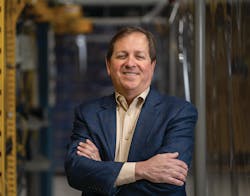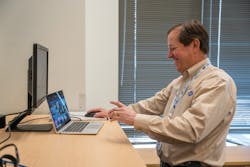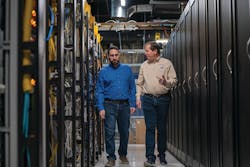ISE EXPO 2022 Keynote Presenter, Ken Paker, SVP of Information and Network Technologies and Chief Technology Officer, TDS
Fiber Passion – Reality Builder
Topic: Priorities
ISE: What are two of TDS’ network-related priorities for 2022?
Ken Paker: Our top priority is to scale up our fiber builds. Fiber remains the most “future proof” technology we work with. We continue to innovate, identifying ways to reduce build costs allowing us to expand our fiber footprint to over a million service addresses in the next five years. Our intent is to drive fiber deeper into the wireline network—wherever and whenever we can make it economically viable, contributing to our efforts to help bridge the digital divide. We would like to reach 2.2 million total service addresses across our traditional ILEC, CLEC, and cable networks with about 60% being fiber and 80% capable of 1Gig or faster speeds.
TDS extends internships to approximately 100 associates annually. In 2021, we expanded that concept to our field technicians. We reach out to high schools and colleges in the rural areas we serve and have built a repeatable process for onboarding these interns with the intent to eventually hire them as full-time associates. It has gone extremely well, better than we thought.
Another network priority is legacy voice switch replacement. Since TDS Telecom has traditionally grown by acquisition, we have a large variety of extremely old switching systems. These switches are getting harder and harder to maintain and are well past their expected equipment lives. In addition to maintenance risk reduction, this initiative is also driven by our need to get our voice products on a more cost-effective infrastructure. Last year we replaced two switches per month, and we will continue that pace until all have been removed, hopefully by mid-2023.
Topic: Fiber Realities
At the end of 2021, TDS had completed construction of 51,000 fiber addresses—adding 20,000 service addresses in the third quarter, surpassing 40% of its Wireline service addresses. While progress was slower than planned due to permitting complexities and contractor scheduling delays, TDS continues to be bullish on its fiber strategy and how it will transform the company in a very meaningful way over the next several years.
ISE: Permitting and workforce challenges are forcing providers to embrace new creative field solutions. Share a few of your favorite strategies/tools/tactics that are helping your teams.
Paker: As we work to increase our fiber footprint, a main goal is to reduce the cost of buried fiber deployments—both cost of initial construction as well as cost to maintain. We have several strategies in our fiber deployment tool kit that are critical to achieving these goals. For example, our studies show the cost of construction could be reduced significantly by reducing fiber counts in residential neighborhood builds. It may sound counterintuitive because we have been taught over the last several decades that you can never have enough fiber. However, when we shrink the conduit size being placed, it takes significant costs out of the construction. With fiber diameters declining and lasers improving, we believe gaudy fiber counts are no longer needed in a residential neighborhood to service the broadband needs even in the long term. Lower fiber counts also lowers maintenance expenses by reducing the number of splices required for restoration if/when fiber is cut. So, the customer experience may be improved.
We are also moving from centralized split PON to distributed split PON to further help this lowering of fiber counts in neighborhoods. Finally, we are deploying optical tap technology at the very ends of the network in some network topologies. In particular, we needed an improved cost structure for subdivisions with cul-de-sacs and back lot easements. This subdivision typology results in many short tails of outside plant that are not extensible. Each of these tails are relatively more expensive to build than the other parts of the subdivision. With optical taps, we can essentially build these houses at the same cost as the rest of the subdivision.
Topic: Your Passion
ISE: Share one problem/challenge you are passionate about solving for the ICT Industry.
Paker: We are passionate about taking costs out of fiber-to-the-home builds. The more we can reduce costs, the more fiber expansion we can accomplish. The construction parts of our business are ripe for digital transformation, but it is not going to look like the transformations in the other parts of our business. Labor costs do not transform the way electronics or software can. We have done a lot with GIS technology in the last four or five years and there is still a lot more that can be done. But construction is a block-by-block activity and the permutations of how to be successful are enormous. It is going to take image recognition technology coupled with superior project management expertise to truly achieve a transformed state. It has never been a more exciting time to be a part of this industry!
Topic: Supply Chain Constraints
ISE: Talk about the supply chain challenges TDS is facing and solutions to “work around” those impediments. How have these constraints created a catch-22 for network providers?
Paker: Supply chain is the bane of our existence in 2021 and 2022. Who would have thought that this would become a household word for every business and consumer! Traditionally, we have spent a lot of time and effort, both as a company and as an industry, on getting very good at just-in-time inventory. Today, in essence, it is the exact opposite. How do we build up inventory to ensure certainty of delivery? Increasing inventory is our first big work effort. This started with CPE but very quickly morphed to also include network and construction equipment. Of course, success relies on vendors being able to accurately forecast their delivery times. Knowing how to match our forecasted needs with vendor lead times requires a level of rigor that is somewhat daunting. Any missteps could cause drastic business impacts such as shutting down customer installations or suspending construction projects. As a result, we have been heavily weighting our decisions toward oversubscription of inventory rather than too little. We view this approach as a temporary phenomenon and, hopefully, we will return to just-in-time inventory management.
Topic: Supply Chain
ISE: In what ways has TDS been challenged by supply chain issues? Are there suggestions you have for the vendor community to help remedy these challenges?
Paker: Vendors are managing supply chain issues inside their companies at a scale that is likely much larger than what we experience. However, it still comes back to the basics of building reliable forecasting processes. We must look at supply chain issues literally across the entire life cycle of the products and components. To help address these problems, I recommend building in even more transparency in our cross-company processes. Ultimately, we are all in this together, we need to get to that level of transparency if we are to find industry-level solutions.
Topic: The Future
ISE: What emerging or disruptive technology excites you the most for the ICT industry? Why?
Paker: I’m a huge fan of augmented technology (but less a fan of virtual reality). Augmented reality is a natural extension to exploring our world and humans have a natural affinity for exploration. I believe there is unlimited potential for education and entertainment with augmented reality.
Topic: TDS Field Service Intern Program
ISE: TDS is expanding its Field Service Technician (FST) Internship Program—a paid internship for individuals 16+. The FST program matches interns with mentors who provide them with valuable on-the-job experiences. Interns assist with on-site installation, troubleshooting, repairs, and maintenance activities. TDS hopes to provide at least 40 internship positions during the spring or summer months nationwide. The first opportunities are being offered in Dane County, Wisconsin. Share the learnings from this program thus far and how your team benefits—outside of the obvious ways.
Paker: TDS has been bullish on all types of internships for several years now. About 10 years ago, we started intern programs for some staff positions. It is a great way to bring new ideas into the company and it was a win-win for both our organization and the interns. TDS extends internships to approximately 100 associates annually. In 2021, we expanded that concept to our field technicians. We reach out to high schools and colleges in the rural areas we serve and have built a repeatable process for onboarding these interns with the intent to eventually hire them as full-time associates. It has gone extremely well, better than we thought. It is a fantastic way to keep our associate base strong and make sure that we have the people we need to run the business going forward. It has traditionally not been easy to recruit experienced talent in many of these rural areas. The development of associates has always been a key success element for TDS Telecom, so this is very consistent with our culture.1
This is another one of those programs where we will never be finished—there will always be ways to improve our operation.
Topic: Proactive Network Management
ISE: ICT industry analysts and observers often focus on service providers’ CapEx budgets. But the reality is that OpEx can make or break a provider’s bottom line. The key to controlling OpEx is to improve network life cycle management for complex fiber and legacy networks in a cost-efficient manner. What are some proactive approaches you recommend to control OpEx?
Paker: We are spending a lot of time and resources on proactive network management and are making strong, consistent progress. Controlling OpEx is certainly a major driver, but it is also about improving the customer experience. If we can find problems and fix them before a fault occurs, everyone wins. We started this effort several years ago in our cable networks since there is so much operational information reported on HFC networks. We are now expanding this project to both DSL and PON networks and will continue to strive to use data analytics to predict problems in the network. This is another one of those programs where we will never be finished—there will always be ways to improve our operation.
Topic: Retaining and Retraining Top Talent
ISE: The great resignation is not ending. How does your team hold onto those professionals with the most talent and the greatest work ethic when they must upskill to remain relevant to TDS? That means these team members must work their “regular” jobs and at the same time learn new skills for the future. They also desire a work/life balance. Share your thoughts about the “rub” of this reality to employers AND employees.
Paker: I love this question because it is important for both employers and employees to recognize that digital transformation benefits both groups. We often talk about digital transformation from the employer’s perspective, typically cost structure related. While that is all true, there are also significant benefits for individual employees.
Take our proactive network maintenance initiatives, for example. Those capabilities will allow our employees to offer a higher grade of service but also on a more natural schedule as opposed to being under pressure due to restoring an outage or fault.
We have seen a lot of quality-of-life improvements for our associates as we go through these transitions. Of course, they are transitions nonetheless and we must always be patient with changes. To encourage adaptation to change, we have a 100% tuition reimbursement program to help employees achieve these transitions and meet their aspirations.
Topic: Network Sustainability
ISE: BCG estimates that action by the ICT industry could eliminate up to 15% of all global emissions by 2030, more than a third of the total emissions reductions needed to meet global sustainability targets. In total 12.1 gigatons of CO2 could be saved, which would equate to $6.5 trillion. What is TDS doing across the network to help hit these aggressive sustainability targets?
Paker: Meeting aggressive sustainability targets requires a multi-faceted approach to achieve the requisite long-term success. The first step is to assess and measure where we are currently. We typically have the data, but it’s not yet been correlated directly to sustainability measures.
That is what TDS Telecom is undertaking now, and we are still in our early maturity stages. We think about this in terms of trends. The headwinds are power consumption of the ever-increasing broadband platforms that provide our broadband services. The tailwinds are often just following the natural evolution of networks towards fiber. Both of our network priorities that we talked about earlier, for example, have side benefits of dramatically improving energy efficiency. But that, of course, won’t be enough. We want to also look at what conditions need to be in place for moving to more electric vehicles in our fleet. It’s somewhat counterintuitive, but there is a lot of economic potential in sustainability. Unleashing the economic potential of sustainability projects for our industry will be the next big thing.2
Topic: Customer Care
ISE: Companies that prioritize innovation and care in redesigning customer experiences will be best positioned to stay ahead of shifting consumer preferences. Share two of your top customer-centric tactics that other providers could borrow.
Paker: TDS Telecom has always had customer service at the center of our corporate culture; it is ingrained in our company’s DNA. But what comprises great customer service has changed radically in the last two years as society has migrated to more online experiences. One approach we are taking is to provide a plethora of online information about our products but also couple that with classic face-to-face sales at community events or even door-to-door sales. The combination of these two is powerful, particularly when we are in the construction phase of our fiber projects. Another approach is having a dedicated customer hotline staffed with customer service professionals for fielding customer issues during the fiber construction period. Fiber construction is disruptive and inconvenient for a neighborhood. Being empathetic to those impacted neighborhoods is hugely important and helps cement a positive first impression of the improved fiber-based services.
Topic: Overlooked Issues
ISE: What should all of us in the Information and Communication Technology (ICT) industry be talking about that we are not? Or, what current topic is the most important that needs additional and different attention?
Paker: We talk a lot about value of broadband, but we often underestimate its value to our overall society. Can you imagine our societal response to COVID-19 had our industry not built out substantial broadband networks prior to the pandemic? There is no debate now that broadband is a critical infrastructure—right there with electricity. Broadband has become a substantial substitute for transportation and a tremendous source of educational equalization benefiting all parts of our society. Believe it or not, we are still at the early stages of Internet maturity and there is so much more potential value to be realized!
Topic: Best Place to Work for LGBTQ+ Equality
TDS received a perfect score on the Human Rights Campaign (HRC) Foundation’s Corporate Equality Index (CEI) and received the designation of being a 2022 “Best Place to Work for LGBTQ+ Equality.3” TDS joins more than 840 major US businesses that also earned the top rating this year.
ISE: Congratulations! Please share one of the strategies TDS embraces that other companies can borrow.
Paker: TDS Telecom was proud to receive a perfect score on the HRC Foundation’s CEI and the designation of being a 2022 “Best Place to Work for LGBTQ+ Equality.3” It was our company’s second year participating in the survey and our second perfect score. At TDS, we live out our corporate commitment to diversity, equity, and inclusion and strive to have a workforce that represents the communities we serve. We have taken many steps to promote diversity, equity, and inclusion from attending LGBTQ+ virtual career fairs to requiring our new associates to attend two web-based trainings that communicate our non-discrimination policy including sexual orientation. The one strategy that is integral to fostering a more inclusive workforce is our commitment to having Associate Resource Groups (ARGs) at TDS. As one of nine ARGs, the 2BU ARGs foster a sense of community within and outside the company by valuing differences, providing an inclusive and safe environment, and helping LGBTQ+ associates succeed. The group is associate-led and associate-driven with events and activities for its members and the entire company. It allows for more education and communication among our diverse and growing workforce. The 2BU ARGs also ensure the company recognizes the contributions from LGBTQ+ associates and members to help us identify organizations with shared values that we can support in our TDS communities.
We think about this in terms of (sustainability) trends. The headwinds are power consumption of the ever-increasing broadband platforms that provide our broadband services. The tailwinds are often just following the natural evolution of networks towards fiber.
Topic: Corporate Empathy
ISE: Now, more than ever, customers are looking for insights into the kinds of companies they can trust. Companies that fail to take the right steps in showing thoughtfulness and empathy could lose their customer base forever. What is your company doing to walk its talk to customers AND employees?
Paker: TDS takes a vested interest in the growth and success of the communities we serve. At the heart of our core company values is being a good citizen and that means giving back to TDS communities. Our efforts range from hands-on volunteering to in-kind and financial support. We not only promote volunteerism, we also have a “Be Good Citizens” program that provides associates with 16 hours of paid time off every year to volunteer. In 2021, roughly 120 associates volunteered 685 hours in this program alone. TDS also celebrates a “Volunteer of the Quarter” and responds to funding requests from communities throughout the year. Each December, our associates vote on a charity of their choice for the company to donate to during the holiday season.
RESOURCES AND NOTES
1. https://tdstelecom.com/about/news/categories/tds/TDS_now_hiring_FST_interns_in_Dane_County_Wisconsin.html
2. “Putting Sustainability at the Top of the Telco Agenda”: https://www.bcg.com/publications/2021/building-sustainable-telecommunications-companies and “BCG-WEF Project: The Net-Zero Challenge”: https://www.bcg.com/en-us/about/partner-ecosystem/world-economic-forum/ceo-guide-net-zero
3. “Best Places to Work for LGBTQ+ Equality 2022”: https://www.hrc.org/resources/best-places-to-work-for-lgbtq-equality-2022
Ken Paker was named CTO in 2014 and appointed SVP of Information and Network Technologies in 2018. He has been with the company since in 1996. Ken has responsibility for technical direction of the company’s network and IT evolution.
He oversees the delivery of software and infrastructure projects across diverse, state-of-the-art network technologies, as well as the company’s mission-critical IT applications and services. He also directs the planning, engineering, and building of TDS’ networks to ensure customers have access to the most reliable Internet, phone, and TV services.
Outside of work, Ken enjoys running and traveling. In fact, he’s been to all 50 states with his wife and daughters. He is a self-described lifelong learner and recently completed a master’s in data science at the University of Wisconsin-Oshkosh. In addition, Ken holds a Bachelor of Science in Computer Science and Biology from Purdue University, a Master in Data Science in Computer Science from the University of Southern California, and a Master of Business Administration from the University of Wisconsin-Madison.
For more information, please visit www.tdsinc.com and www.tdstelecom.com. Also, follow TDS on Twitter @tdstelecom, LinkedIn: tds-telecommunications-llc, and Facebook: TDSTelecommunications.
About the Author
Sharon Vollman
Content Ambassador for ISE EXPO
Sharon Vollman is the Content Ambassador for ISE EXPO. She is passionate about collaborating with thought leaders, SMEs and hard-working doers who design, plan and deploy ultra-reliable broadband networks. Vollman is committed to creating a variety of educational offerings for ISE EXPO attendees that inspire them to connect every U.S. citizen with the broadband networks we all want for our children and grandchildren.
Vollman has created educational partnerships with Broadband Service Providers including AT&T, Verizon, Lumen, Frontier Communications and others. She has covered the telecom industry since 1996.





